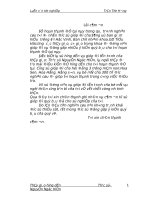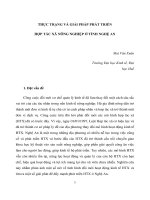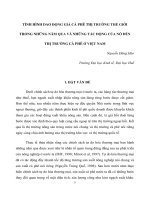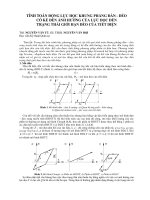Báo cáo nghiên cứu khoa học: "Tình trạng suy dinh dưỡng và các yếu tố liên quan trong trẻ em dân tộc thiểu số dưới 5 tuổi Trong bắc Trà My, tỉnh Quảng Nam trong năm 2010." docx
Bạn đang xem bản rút gọn của tài liệu. Xem và tải ngay bản đầy đủ của tài liệu tại đây (141.41 KB, 11 trang )
39
JOURNAL OF SCIENCE, Hue University, N
0
61, 2010
MALNUTRITION STATUS AND RELATED FACTORS WITHIN ETHNIC
MINORITY CHILDREN UNDER 5 YEARS OLD
IN NORTH TRA MY DISTRICT, QUANG NAM PROVINCE IN 2010
Dinh Dao
Quang Nam Central General Hospital
Vo Van Thang
Hue College of Medical and Pharmacy
Do Thi Hoa
Hanoi Medical College
SUMMARY
The number of malnourished children in Vietnam has reduced remarkably in recent
years, but in mountainous and ethnic minority areas, the children malnutrition rate is still very
high. We conducted this study in 9 poor communes where about 90% of the population belong to
the ethnic minorities of North Tra My district, Quang Nam province with the following
objectives: (1) to determine the malnutrition rate in ethnic minority children under 5 years old
in North Tra My; (2) to describe factors related to the malnutrition rate in children under 5
years old at this location; (3) to propose solutions for feasible and sustainable interventions to
improve the level of malnutrition in children under 5 years old. Methods: Using a cross-
sectional descriptive study, combining quantitative and qualitative methods in January, 2010,
with a random sample including 1200 ethnic minority children under 5-year-old and their
mothers; by weighing and measuring children's height, interviewing mothers. Results: The
malnourished prevalence rate of underweight was 36.5%, in which 28.3% level I, 6.8% level II,
and 1.4% level III; the stunting 62.9% and the wasting 8.6%; In-depth interviews show that
many mothers don’t let their children at eat protein-rich, available and fat- rich food because of
they are afraid of it causing them abdominal pain and diarrhea. Conclusion: Some factors as
child's age, weight at birth, exclusive breastfeeding within 6 months, time of the first additional
feeding, child's acute respiratory infection, the child feeding practices that mother’s lack
knowledge about: using protein-rich and fat-rich food, using protein-rich, available food locally,
mother’s low educational level, poor economic conditions of families; dieting during pregnancy,
going to work soon after birth, the limited capacity of health officials, a lack of interest of local
leaders are the related factors to the child's malnourished status.
Key words: ethnic minority children malnutrition.
40
1. Introduction
The national program for preventing and controlling child malnutrition has been
deployed in Vietnam for many years and has achieved remarkable results. However the
malnutrition rate amongst children is still very high in mountainous areas, within ethnic
minorities and the rate is different among regions. Scientific evidence is needed for
feasible solutions which are selected by the communities themselves. This is an
effective and sustainable approach. North Tra My, a high mountainous district of Quang
Nam province, has 9 poor communes in which about 90% of people belong to ethnic
minorities. Priority health issues such as child malnutrition require attention. Therefore,
we conducted this research to determine the malnutrition rate of ethnic minority
children under 5 years old in North Tra My district; describe factors related to
malnourished children under 5 years old at this location; and propose feasible and
sustainable interventions to improve malnutrition in children under 5 in this location.
2. Methodology
2.1. Subject and setting:
- Subject research:
+ Ethnic minority children under 5 years old and their mothers
+ The commune leaders, village leaders, other officials of departments such as
women, youth, the village elders.
- Setting: 9 poor communes of North Tra My district, Quang Nam province.
2.2. Research Method:
- Study Design: A cross-sectional descriptive design was used, combining
quantitative and qualitative methods
- Sample size and sampling.
+ Sample size: The formula calculating sample size for a rate was used:
2
2
2/1
1
d
pp
Zn
With a 95% CI (confidence interval), Z (1 - α / 2) =1.96, estimated p =
0.35; accepted d = 0.04;
Counts n = 546. Using two - stage sampling so a reasonable sample size
is: 2n = 1092
Estimated 5% drop out and rounding off, sample size required is 1200
+ Sampling:
41
For children: a two - stage sampling strategy was used:
Stage 1: Randomization was used to select 6 out of 9 poor communes: Trà
Giáp, Trà Giác, Trà Đốc, Trà Tân, Trà sơn và Trà Kót.
Stage 2: A random sampling method was used to choose children
For mothers: All the mothers of selected children were included.
- For qualitative research: intentionally selected in accordance with the
component mass and standard sampling
- Methods and data collection tools:
+ Nutritional Status: Using anthropometric measurements, children were
weighted and their height was measured using a specialized tool. The children’s age was
calculated according to the children’s standard of the Vietnam Nutrition Institute.
Nutritional Status Grading was calculated using a new WHO classification in 2006, the
Vietnam Nutrition Institute has been deployed and applied in the community since June
2008. Children with weight/age (W/A), height/age (H/A) and weight/height (W/H)
under -2SD (standard deviation) were considered to be malnourished by the
classifications of underweight, stunting and wasting, respectively.
+ Relevant factors: Interviews based on the "survey list" were prepared. In-depth
interviews and group discussions were organized at each commune
2.3. Handling and analyzing data: The software Epi Info 6.04a was used to
analyze data. χ2 test (chi - squares test), P-values (probability-value) and OR (odds
ratio) were used to analyze the relative factors
2.4. Research period: January, 2010.
3. Results
3.1. Rate of child malnutrition
Table 3.1. Prevalence of malnourished children according to form (n = 1200)
Malnutrition
form
Normal
Malnutrition
number
Malnutrition
Percent (%)
95% CI
Underweight 762 438 36.5 33.8 – 39.2
Stunting 445 755 62.9 60.2 – 65.6
wasting 1097 103 8.6 7.1 – 10.2
Table 3.1. Shows the prevalence of wasting is the highest (62.9%)
42
Table 3.2. The prevalence of underweight based on level
Level Level I Level II Level III Total
Frequency 339 82 17 438
% 28.3 6.8 1.4 36.5
Table 3.2. Shows the prevalence rate of underweight is mainly at level I; but still
1.4% at level III.
3.2. Some factors related to the malnutrition status of children
Table 3.3. Relationships between the survey factors with the malnutrition Status of children
No. Factor n Malnutrition % P
1.
Age (month)
0 - 12
13 - 24
25 - 36
37 - 48
49 - 60
246
257
239
226
232
62
89
102
98
87
25.2
34.6
42.7
43.4
37.5
p < 0.001
2. Gender
Male
Female
637
563
245
193
38.5
34.3
p > 0.05
3.
Weight at birth
(grams)
2500
< 2500
986
214
345
93
35.0
43.5
p < 0.05
OR= 1.5
( 1.1<OR<1.9)
4.
Location
(commune)
Trà Đốc
Trà Giáp
Trà Tân
Trà Kót
Trà Giác
Trà Sơn
237
243
120
145
258
197
81
105
37
44
107
64
34.2
43.2
30.8
30.3
41.8
32.5
p > 0.05
5.
Breastfeeding in
the first hours
after birth
Yes
No
1083
117
393
45
36.3
38.5
p > 0.05
43
6.
breastfeeding
completely
within the first
six months
Yes
No
370
830
113
325
30.5
39.2
p < 0.01
OR=1.3
(1.0<OR<1.6)
7.
The first time
for children to
eat food
Right
Wrong
374
826
114
324
30.5
39.2
p < 0.01
OR = 1.5
(1.1<OR<1.9)
8.
Time to wean
(months)
< 18
18
203
997
75
363
36.9
36.4
p > 0.05
9.
Acute
respiratory
infection (last 2
weeks)
Yes
No
748
452
341
97
45.6
21.5
p < 0.001
OR=3.1
( 2.3<OR<4.0)
10.
Diarrhea (last 2
weeks)
Yes
No
352
848
138
300
39.2
35.4
p > 0.05
11.
Using protein-
rich food daily
Yes
No
531
669
137
301
25.8
45.0
p < 0.001
OR= 2.4
( 1.8<OR<3.0)
12.
Using protein-
rich, available
food daily
Yes
No
237
963
62
376
26.2
39.0
p < 0.01
OR = 1.8
( 1.3<OR<2.5)
13.
Eat fat - rich
food daily
Yes
No
389
811
93
345
23.9
42.5
p < 0.001
OR = 2.4
( 1.8<OR<3.1)
14.
Ethnicity of
mother
Cadong
Cor
Other
842
275
83
313
97
28
37.2
35.3
33.7
p > 0.05
15.
Education of
mother
Illiteracy
Primary
Junior
256
354
590
112
135
191
43.8
38.1
32.4
p < 0.01
44
16.
Level of family
economics
Enough
to eat,
comforta
ble,
poor
446
754
120
318
26.9
42.2
p < 0.001
OR=2.5
( 1.9<OR<3.2)
- Table 3.3 show that child's age (p<0.001), weight at birth (p<0.05, OR=1.5),
breastfeeding completely feeding within 6 months (p<0.01, OR=1.3), time of first
additional feeding (p<0.01, OR= 1.5), child's acute respiratory infection (p<0.001,
OR=3.1), a lack of protein-rich and fat- rich food (p<0.001, OR=2.4), using protein-rich,
available food at its local (p<0.01, OR=1.8), mother's low educational level (P<0.01),
and poor economic conditions of families (p<0.001, OR=2.5) are factors related to the
child's malnourished status.
- An association between the malnutrition status of children and other factors
was not found: gender, place of residence, ethnicity of mother, breastfeeding in the first
hour after birth, time of weaning, and children with diarrhea in past two weeks.
3.3. Results deep interviews and workshops in the communes
3.3.1. In-depth interviews of mothers show that
- Many mothers don’t let their children eat protein-rich, available and fat- rich
food because they are afraid of their children suffering abdominal pain and diarrhea,
- Nutritional collaborators practice the nutritional model only once per year;
using expensive food and not transferring the practices to participating mothers
(mothers could not imitate),
- None of the communes have markets. Local people do not know how to
preserve and store food.
- Self dug toilets and a lack of toilet is still common. Therefore hygiene is poor.
- All mothers believe in the advice of village elders and village leaders
- In each village there are also poor mothers, but their children are still healthy.
They don’t put their children on a diet. They feed their children protein and fat rich
foods that are available regularly, and are easy to access daily.
3.3.2. In-depth interviews of commune and village officials and locals show:
- Pregnant women don’t eat much, do not eat nutrients, and have to work hard
because they believe that those activities will make their baby smaller, and consequently
be easy to deliver.
- Pregnant women have the habit of drinking alcohol, and returning to work
soon after birth. These practices are bad for both the mother and child.
45
- Festivals are often organized, but many fathers do not have the habit of saving
food for shortage months, and do not try to find protein-rich foods for their child which
are available locally.
- Local organizations showed a lack of interest. They did not focus on giving
nutritional information to the population monthly and the study area had difficult
economics. The poor health of children could be due to the fact that nutritious food is
not readily available and environmental sanitation is limited.
3.3.3. Results of the workshops in the communes: At the workshops in the
communes, the solutions are highly unified about the content and course of action as
follows:
- Strengthening the role of the leadership of Party, the administration of local
government, the coordination of agencies and organizations in each commune and each
village.
- Establishing steering committees for preventing and controlling child
malnutrition in each commune, as well as a village self-management team at each
village with each member being assigned specific tasks.
- Unifying the activity plan of preventing and controlling child malnutrition in
2010, including:
+ Group Discussion about typically poor mothers feeding healthy children"
protein-rich and available food at their local";
+ Organizing monthly nutritional practices in each village;
+ Training in communication skills for the network of nutritional collaborators;
+ Training of supervisor and evaluation skills for commune officials, village
elders and village leaders;
+ Integrating media to educate feeding behavior every month in order to change
mothers’ behavior;
+ worming every 6 months for children up to two-years-old;
+ Supplying iron, folic acid, and zinc for children up to six-months-old;
+ Organizing competitions for mothers feeding healthy children;
+ Organizing competitions for good nutritional collaborators;
+ Mobilizing all people to participate in the movement: "the cultural village,
food security, food safety for the development of children" by the village leaders and
village elders, under the direction and administration of the commune People's
committees.
46
Criteria
Cultural village: the birth of no more than two children; clean and hygienic
villages; the use of sanitary latrines; not abstain from food, and not drinking alcohol
whilst pregnant;
Food security: encourage parents to save food for the months between crop
periods; encourage parents to feed their children daily with foods containing protein, fat,
fruits and vegetables from locally available food.
Food safety: Help each other to learn how to preserve animal fat and protein for
use over many days; maintain hygiene whilst eating by wash hands with soap before
eating and after using the toilet.
Holding final workshops about activities to prevent and control malnutrition
children and self-management model.
4. Discussion
4.1. Prevalence rate of malnutrition
- Based on the weight for age index: Weight is the picture of the child’s
nutritional status at the time of measurement. Research results show that the
underweight prevalence rate of ethnic minority children under five-years-old in poor
communes of North Tra My district is 36.5% (95% CI: 33.8% - 39.2% ). According to
the WHO classification this is very high. The underweight rate of malnourished children
in this study is equivalent (p>0.05) with the percentage of underweight malnourished
children under age 5 in Tra Linh highland commune, south Tra My district in 2008
(39.4%). This percentage (36.5%) is higher (p<0.05) than the rate of underweight
children under 5 years old in Hai Chanh commune, Hai Lang district (Quang Tri
province) in 2003 (29.2%), as well as in Cam Thuy district, Thanh Hoa province in
2007 (30.8%) and much higher than the national rate in 2008 (19.9%) (p < 0.001). The
National prevention and control program for malnourished children is effective in many
regions in the country, but of which impact is limited to these communes. This
percentage (36.5%) is a measure of the true socio-economic level of research locals.
- Based on the height for age index: Height is a measure of the historical
development of child. A child with low height (compared with age) demonstrates
children who were previously frequently malnourished children and often occurs in
populations which lack food for long periods, which causes chronic malnutrition.
According to the WHO, the rate of 62.9% (95% CI: 60.2% - 65.6%) of stunting in
children under five years old is very high. It is higher than in other areas such as in
South Tra My (49.6%); in Cam Thuy, Thanh Hoa (24.6%); 29.9% of Soc Son in Ha
Noi; 29.6% of the nation in 2005. It shows that stunting malnutrition is still a common
situation in our country's children now.
47
- Based on the weight for height index: This indicator shows children with acute
malnutrition but if a baby lacks of both weight and height for age, the index can be still
normal. The wasting rate in these communes is 8.6% (95% CI: 7.1% - 10.2%). This is
similar to the national rate (8.6%) and lower than nearby Tra Linh (12.3%); because the
stunting rate in these communes (62.9%) is much higher than the rate of underweight
itself (36.5%), the wasting rate here is low as shown.
4.2. Factors related to malnourished children
- Age and malnutrition: Table 3. Shows that a change in the rate of malnutrition
in children increases quickly from 1 year old (25.2%) to 2 years old (34.6%), and
reaches the top at age 4 (43.4%). This is a consequence of rearing children. Around 2
years old is the most difficult period in the life of a child because they gradually stop
breastfeeding and begin to eat the solid food. They are threatened by external
environmental factors, especially microorganisms that cause respiratory and digestion
diseases, etc , that are reason for children of the 4-year-old group having the highest
rate of malnutrition. At the age of 5, the malnutrition rate is lower (37.5%), maybe this
is the result of the national program to prevent and control children malnutrition and
other socio-economic programs (such as Program 134 and 135).
- The other elements that remain in relation to the malnutrition status of children
are identified in this study (Table 3) essentially as the malnutrition risk factors for
children; these factors have been raised by WHO. Particularly, small children are
vulnerable because their development is rapid, requiring a lot of energy, and having
nearly no energy reserves, they must undergo a period of gradual adaptation to the food
of adults and they are also influenced by frequent infections, parasites, viruses, etc
Those risks occur mainly in developing world countries, especially because of poverty,
high birth rates per family, environmental pollution, etc ; leading to the existence of a
high rate of infectious diseases and malnutrition. This situation repeats through
generations, creating a cycle which is difficult to solve. This is clearer in research
setting.
4.3. The interventional solution
Many intervention solutions are based on related factors and are found in areas
that that community may have deployed effectively for many years such as " the
interventional model basing on community participating together" of Dam Khai Hoan;
"interventional model basing on specific contexts and gender-sensitive" by the authors
Vo Van Thang, Dao Van Dung and “diversifying the forms of communications, and
health education” of Nguyen Thi Kim Lien
In the North Tra My mountainous district, when we organized workshops,
reported research results, learned about the related factors of malnutrition of ethnic
minority children, the majority of delegates attending the meeting are supportive of the
48
“interventional model basing on village elders, village leaders" under the direction of
commune leaders; the coordination of the health departments, organizations and local
residents to make a better plan as agreed.
Thanks to innovation in recent years, our country has become one of the leading
rice exporters in the world. Vietnam is no longer a poor country, but we need to have
time to raise the education level of the people. Health education in general, and guiding
mothers on how to bring up and take care of children in particular need to be further
strengthened, especially for ethnic minorities who have been living in mountainous,
border and island areas.
5. Conclusion
5.1. Prevalence of malnutrition
The malnutrition prevalence rate of underweight was 36.5%, in which 28.3%
was level I, level II was 6.8% and 1.4% was level III; stunting was 62.9% and wasting
was 8.6%.
5.2. Some relevant factors
The child's age, weight at birth, exclusive breastfeeding within 6 months, time of
the first additional feed, child's acute respiratory infection, mother’s practices regarding
feeding their child protein-rich and fat-rich food every day, using protein-rich, available
food that is locally available, mother’s low educational level, poor economic conditions
of families; dieting during pregnancy, returning to work soon after birth, the limited
capacity of health officials, and a lack in interest of local leaders are all factors related
to the child's malnutrition status.
6. Recommendation
These problems can be addressed through building an "interventional model of
preventing and controlling malnourished children based on village elders and village
leaders" under the directions of commune leaders; and the coordination of the health
departments, organizations and local residents.
REFERENCES
1. Nguyen Van Cam and associates. Research status of malnourished children under 5
years old and some related factors in Tra Linh, Nam Tra My district in 2008. First
Proceedings of scientific meeting, in 2008; Nam Tra My Hospital, 48-52.
2. Khai Hoan Dam. Research to build a model community to join in the activities of
health care for people in northern mountainous regions. PhD thesis medicine, Hanoi.
1998; 126 – 127.
49
3. Nguyen Thi Kim Lien. Assessment of the status and efficient solutions of a
communicational intervention, health education in children's health care system at
medical facilities. PhD thesis medicine. 2006; 87.
4. Public health Department - Hanoi Medical College , "Choosing sample, sampling size
in epidemiological study", " Technique and tool collecting information", Methods of
scientific research in medicine and public health, Medicine Publisher. 2004; 58-95.
5. Ministry of Health, National Institute of Nutrition. Guide to assess nutritional status
and food in a community, Hanoi Medical Publishing Houses. 1998; 13-16, 59-72,
6. Dinh Thanh Hue. Status of malnourished children under 5 years old Hai Chanh
commune, Hai Lang, Quang Tri in 2003. Journal of preventive medicine, group XIV,
No. 4. 2004; (68), 70-74.
7. Ministry of Health, National Institute of Nutrition . “Summary Report of the health
works in 2008 and plan in 2009”, Journal of Practical Medicine No. 1 / 2009 (641-
642), 40-10.
8. UNICEF. The state of the world's children 1998, Published for UNICEF by Oxford
University press. 1998; 11, 24.
9. Vo Van Thang, Dao Van Dung. “Interventional Model basing on Advancing
reproductive health care service and family planning using in 7 poor communes, Nam
Dong district, Thua Thien Hue”, Journal of Practical Medicine No. 8 (517). 2005; 70-
73.
10. WHO. Child Growth standards Methods and Development. XVII. 2006; 226.









